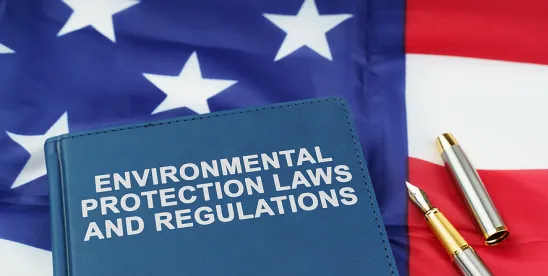Key Takeaways
- What Happened? On October 11, 2024, the U.S. Environmental Protection Agency (EPA) published a final rule establishing the Emissions Reduction and Reclamation (ER&R) Program to manage certain hydrofluorocarbons (HFCs) and their substitutes (collectively, HFCs) for the purpose of maximizing reclaiming and minimizing releases of HFCs from certain equipment or appliances. The ER&R Program is intended to implement subsection (h) of the American Innovation and Manufacturing Act (AIM Act), 42 U.S.C. § 7675.
The rule finalizes two distinct sets of regulations:
- The ER&R Program; and
- Resource Conservation and Recovery Act (RCRA) alternative standards for ignitable spent refrigerants that are “recycled for reuse.”
The ER&R Program’s main components are:
- Leak repair requirements for certain appliances that use a refrigerant containing HFCs;
- Mandatory use of automatic leak detection (ALD) systems for certain HFC-containing new and existing appliances;
- A reclamation standard limiting the amount of virgin HFCs that can be contained in reclaimed HFCs;
- Mandatory use of reclaimed HFCs when servicing and/or repairing existing equipment in specific refrigeration, air conditioning, and heat pump (RACHP) sector equipment that utilizes HFCs;
- Fire suppression sector requirements related to servicing, repair, disposal, and installation of fire suppression equipment that contains HFCs, as well as technician training requirements;
- Removal requirements for HFCs from certain disposable cylinders before discarding; and
- Recordkeeping, reporting, and labeling requirements.
- Who is Affected? The rule applies to a wide range of entities that own, operate, service, repair, recycle, dispose of, or install equipment containing HFCs, such as commercial and industrial refrigerators, air conditioners, heat pumps, fire suppression systems, and other HFC-containing equipment. These are widely used substances, and as a result, almost any commercial facility with HVAC equipment is potentially affected. The rule may also affect entities who manufacture or sell HFC-containing equipment. The rule also applies to those entities that recover, recycle, or reclaim HFCs. Affected companies will include companies in the manufacturing, retail, technology, and transportation sectors.
- What Should You Do? Entities potentially subject to these new regulations should carefully review the rule. Petitions for judicial review of the ER&R Program regulations must be filed in the U.S. Court of Appeals for the District of Columbia Circuit by December 10, 2024. Petitions for judicial review of the RCRA alternative standards regulations must be filed in the U.S. Court of Appeals for the District of Columbia Circuit by January 9, 2025. Parties with questions regarding the rule’s requirements or potential legal challenges should contact Beveridge & Diamond.
Analysis and Key Elements of the Final Rule
The AIM Act authorizes EPA to address HFCs in three primary ways:
- Phasing down HFC production and consumption through an allowance and allocation program—the “Allocation Framework Rule;”
- Facilitating the transition to next-generation technologies by restricting the use of HFCs in certain sectors or subsectors—the “Technology Transition Rule;” and
- Maximizing reclaiming and minimizing releases of HFCs from equipment.
This rule focuses on the third area—maximizing reclaiming and minimizing releases of HFCs. Subsection (h) of the AIM Act, titled “Management of Regulated Substances,” directs EPA to “promulgate regulations to control, where appropriate, any practice, process, or activity regarding the servicing, repair, disposal, or installation of equipment” that involves HFCs (regulated substances) and the reclaiming of HFCs.
Stakeholders submitted varied comments on the proposed rule, and the final rule departs from the proposed rule in several ways. Notable final rule departures include EPA’s decision not to finalize (i) requirements that the initial fill of equipment use reclaimed HFCs and (ii) the proposed container tracking system. However, EPA notes that it intends to further consider initial fill and container tracking provisions for potential subsequent rulemakings.
Notable aspects of key final rule requirements are discussed below.
- Leak Repair Requirements. Refrigerant-containing appliances with a full charge of 15 pounds or more of a refrigerant containing an HFC with a global warming potential (GWP) greater than 53 must repair leaks to achieve a leak rate below the applicable thresholds:
- Industrial process refrigeration subsector: 30%;
- Commercial refrigeration subsector: 20%; and
- Comfort cooling, refrigerated transport, and other non-specified appliances subsector: 10%.
While the proposed rule included bifurcated compliance dates based on the appliance’s refrigerant charge size, in the final rule, EPA established a single compliance date for all covered appliances of January 1, 2026.
In addition, the final rule includes a “narrow” exemption from the leak repair provisions for refrigerant-containing appliances in the residential and light commercial air conditioning and heat pumps subsector.
While EPA finalized many of the proposed retrofit and retirement plan requirements, the Agency did not finalize a proposed provision that would have required a retrofit to utilize a lower-GWP alternative than the original refrigerant.
- Automatic Leak Detection (ALD) Systems. Owners and operators of refrigerant-containing appliances in the industrial process refrigeration (IPR) and commercial refrigeration subsectors must install and use ALD systems for new and existing equipment that has a refrigerant charge size of 1,500 pounds or more, and that contains an HFC with a GWP greater than 53. EPA significantly extended the proposed timeline for compliance with ALD system requirements. The final rule sets a January 1, 2026 compliance date for new refrigerant-containing appliances exceeding the size and GWP thresholds in the IPR and commercial refrigeration subsectors, and January 1, 2027, as the compliance date for existing equipment (i.e., installed after January 1, 2017, and before January 1, 2026) in these subsectors.
- Mandatory Use of Reclaimed HFCs. While EPA had proposed that initial charges, servicing, and repair of RACHP equipment in certain subsectors must be completed with reclaimed HFCs, the final rule only requires that reclaimed HFCs be used for service and repair. That obligation does not start until January 1, 2029. EPA also established a reclamation standard, providing that reclaimed HFC refrigerants cannot contain more than 15% of virgin HFCs by weight. This standard applies at the batch level, and the compliance date is January 1, 2026.
- Fire Suppression Systems. The final rule includes several requirements with varied compliance dates for fire suppression equipment containing HFCs. Key elements include that HFC releases must be minimized during servicing, repair, disposal, and/or installation by January 1, 2026. In addition, starting on January 1, 2030, the initial installation of HFC-containing fire suppression equipment must use recycled HFCs. The rule also finalized a one-time training requirement for fire suppression technicians.
- HFC Removal from Disposable Cylinders. Despite numerous comments disagreeing with EPA’s proposal, the final rule requires the removal of HFC “heels” from certain disposable cylinders by a certified reclaimer, fire suppressant recycler, or final processor (e.g., landfill operator, scrap metal recycler). The final rule also includes an alternative compliance method. The compliance date for these requirements is January 1, 2028.
- RCRA Refrigerant Recycling Alternative Standards. EPA established alternative standards under the RCRA regulations at 40 C.F.R. Part 266, Subpart Q for reclamation facilities recycling lower flammability HFCs (i.e., Class 1, 2, and 2L) for reuse. These alternative standards will apply instead of the full suite of RCRA hazardous waste requirements. Applicability of the alternative standards is limited to ignitable spent refrigerants recycled for reuse in the United States, and the alternative standards require that off-site recycling for reuse be performed at an EPA-certified reclaimer. Ignitable spent refrigerants recycled and intended for export do not qualify for the alternative standards, and entities engaged in these activities must comply with the full suite of applicable RCRA requirements.








 />i
/>i

